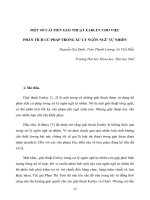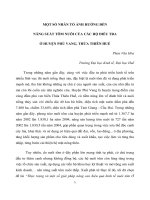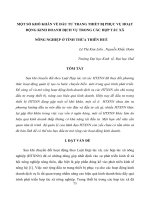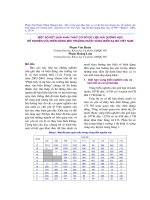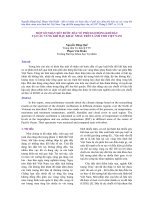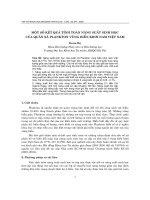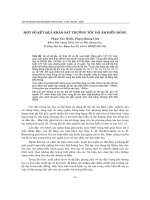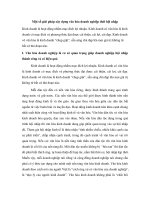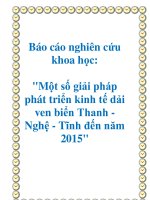Báo cáo nghiên cứu khoa học: "Một số yếu tố quyết định của nhiễm trùng đường tiết niệu ở trẻ em từ 2 tháng đến 6 tuổi ở Hải Phòng Việt Nam trong năm 2008" ppsx
Bạn đang xem bản rút gọn của tài liệu. Xem và tải ngay bản đầy đủ của tài liệu tại đây (104.39 KB, 7 trang )
31
JOURNAL OF SCIENCE, Hue University, N
0
61, 2010
SOME DETERMINANTS OF URINARY TRACT INFECTION IN CHILDREN
FROM 2 MONTHS TO 6 YEARS OLD IN HAI PHONG VIETNAM IN 2008
Dang Van Chuc, Nguyen Ngoc Sang, Dang Viet Linh
SUMMARY
This research was conducted to establish some determinants of urinary tract infections
(UTI) in children from 2 months to 6 years old in some areas of Haiphong in 2008. Method:
Cross-sectional study. Results and Conclusions: “Poverty”, “Underweight weight
malnutrition”, “Phimosis” and incorrect washing method after children have passed stools
were statistically significant with the presence of UTI using a logistic regression analysis. There
was a relationship between UTI development, poverty and poor knowledge of child hygiene.
Keyword: Urinary Tract Infection, Determinant.
1. Introduction
Urinary Tract Infections (UTI) are of interest to scientists because they can lead
to renal scarring, which causes dangerous complications when children grow up such
as: anemia, hypertension (7-17%), preeclampsia, eclampsia, renal failure and end stage
nephropathologies. Most research has been conducted in hospitals to determine the
incidence of UTI, type of bacteria and treatment effectiveness. In Vietnam, no studies
have been conducted in the community to evaluate the Prevalence rate, In particular, to
determine some risk factors of UTI. Therefore, this study was conducted with the
following objectives:
Determine some risk factors of UTI in children from 2 months to 6 years old in
some areas of Haiphong, Vietnam.
2. Methodology
2.1. Population and study time
All children from 2 months to 6 years old in some areas of Haiphong.
Study duration: 7/2007-10/2007.
Criteria of UTI: Leucocyturia ≥ 30/mm
3
and bacteriuria ≥ 10
5
/ml urine.
2.2. Method
Study location
32
3 districts representative of Haiphong district, which were coastal, rural and
urban.
Study design
Cross-sectional and descriptive study.
Sample size was calculated according to the following formula:
2
2
2/1
1
d
pp
Zn
n: Sample size
Z
2
1-α/2
= (1, 96)
2
(confidence 95%)
p = 0, 04 (UTI rate in children of Haiphong after Nguyen Ngoc Sang et al in one
commune in 2005)
d= (p*
) or 20% of p
So approximately 4610 children were needed for the study.
Sampling process: Multistage sampling was used.
The 3 districts chosen were Kien An (urban), Kien Thuy (coastal) and Thuy
Nguyen (rural). The 9 communes/ quarters selected were Nam son, Trang Minh and Van
Dau (Kien An), Dai Ha, Tan Trao and Ngu Doan (Kien Thuy), Phuc Le, Lap Le and Pha
Le (Thuy Nguyen).
Data collection:
+ Identification of UTI:
We carried out screening of midstream urine of children in the morning to detect
UTIs. In the previous night and in the morning the child’s genitals were cleaned using
safe water and soap. The first urine was eliminated and 5 ml of midstream urine was
collected in a neutral tube. If the urine sample has leucocyturia ≥ 30/mm
3
, it was
cultured to identify bacteriuria. A UTI was identified if urine sample had both
leucocyturia ≥ 30/mm
3
and bacteriuria ≥10
5
/ml.
+ Parental interview:
Parental interview of socio-economic conditions, and the child’s history of
disease.
+ Complete examination:
Pediatricians examined children for diseases, particularly genitor-urinary
diseases. Anthropometry was completed to evaluate children’s nutritional status.
33
Data treatment:
SPSS version 13.0 was used for entering and analyzing data, determining UTI
rate and risk factors.
Cases were dependent variables and socio-economic conditions, child’s diseases
were independent variables. UTI and risk factors were associated when OR>1, p<0.05
or OR<1 and p<0.05. Confounding was eliminated by Logistics Regression.
3. Results
3.1. Common information:
- The urine of 4631 children was screened, of whom 2268 were boys (49%); and
2363 were girls (51%); there were children in rural were 1603 (34.6%) children in rural
areas, 1568 (33.9%)in coastal, and 1460 (31.5%) in urban arras. The Common UTI rate
was 2.8%.
3.2. Some risk factors of UTI:
Table 1. The relationship of socio-economic conditions and UTIS
Risk
factors
Exposure n Rate %
OR Bi
variables
95%CI
OR
Multi
variables
95%CI
Maternal
education
<
secondary*
105 3.1
1.7 1.1-2.7
≥ secondary 23 1.8
Paternal
education
< secondary
*
109 3.3
2.2 1.3-3.7
≥ secondary 19 1.5
Economy
Poverty* 29 5.8
2.5 1.6-3.8 2.9 1.3-6.5
Non poverty
99 2.4
Water
Unsafe
water
31 2.6
0.9 0.6-1.3
Safe water 97 2.8
Ware of
UTI
Unware of
UTI
115 2.8
1.2 0.7-2.2
Ware 13 2.3
Paternal Indirect
84 3.6 1.9 1.3-2.8
34
care of
child
paternal
care of
child*
Direct care 44 1.9
Remarks: Significant factors with asterisk included “maternal education level
less than secondary school”, “poverty”, “indirect paternal care of the child”. With
multivariable analysis, only “poverty” remained significant.
Table 2. The relationship of socio-economic conditions and UTIs (continued).
Risk
factors
Exposure n Rate %
OR Bi
variables
95%CI
OR
Multi
variables
95%CI
Maternal
care of
child
Indirect
maternal care
of child*
71 3.9
1.9 1.4-2.8
Direct care 57 2.0
House
Stable 73 2.5
0.7 0.5-1.1
Unstable 55 3.3
Lavatory
Unhygienic
lavatory
58 2.3
0.65 0.4-0.9
Hygienic
lavatory
70 3.4
House’s
square
< 20 m
2
98 2.5
0.5 0.3-0.8
≥ 20 m
2
30 4.3
Remarks: “Indirect maternal care of the child” had a statistically significant
association with UTI in bivariate analysis but it was not significant in multivariable
analysis. Others were not significantly associated with UTI.
Table 3. The relationship between hygienic factors and UTI.
Risk
factors
Exposure n Rate %
OR Bi
variables
95%
CI
OR
Multi
variables
95%CI
Hygiene
after
urination
Clean* 102 3.3
1.9
1.3-
3.0
Clean and
26 1.8
35
washing
Diaper
Yes* 23 5.8
2.4
1.5-
3.8
No 105 2.5
Hygiene
after stool
Clean * 99 3.2
1.7
1.1-
2.6
Clean and
washing
29 1.9
Remark: Factors such as “Incorrect washing method after urination and Passing
stools”, and “diapers”, were significantly associated with UTI in bivariate analysis but
they were not significantly associated in the multivariable one.
Table 4. The relationship of hygienic factors with UTI (continued).
Risk
factors
Exposure n Rate %
OR Bi
variables
95%CI
OR
Multi
variables
95%CI
Way of
washing
after stool
Back-
ward*
123
2.9
2.6 1.1-6.3 1.9 1.2-3.9
Back-
ward, in
place
5 1.2
Kinder-
garten
Yes 94 2.6
0.9 0.5-1.1
No 34 3.3
Preschool
Yes 16 2.5
0.8 0.5-1.4
No 112
2.8
Remark: Factors such as “incorrect washing method after urination and passing
stools” were statistically significant in bivariate and multivariable analysis. Others were
not significant.
Table 5. The relationship of child’s diseases and UTIS.
Risk
factors
Exposure
n Rate %
OR Bi
variables
95%CI
OR
Multi
variables
95%CI
Stunting Yes * 49 3.5 1.4 1.0-2.1
36
No 79 2.4
Under
weight
Yes * 41 4.0
1.6 1.1-2.4 1.7 1.1-3.3
No 87 2.4
Wasting
Yes * 26 4.7
1.97 1.3-3.3
No 102 2.5
Phimosis
Yes * 30 6.6
6.6
3.7-
11.9
6.7
3.7-
12.2
No 19 1.0
Consti
pation
Yes * 44 4.6
2.0 1.4-2.9
No 84 2.3
Enuresis
Yes * 81 3.3
1.5 1.1-2.3
No 45 2.1
Remark: Factors marked with an asterisk were significant in bivariate analysis,
including “Malnutrition of all kinds”, “phimosis”, “constipation” and “enuresis”. In
multivariable analysis, only “phimosis and “low weight malnutrition” were significantly
associated with UTIS.
4. Discussion
4.1. Socio-economic conditions and maternal education level:
Table 1, 2 showed that “poverty”, paternal education level under secondary
school”, and “indirect paternal care of child” were significantly associated with UTI.
The results revealed the relationship between poverty, ignorance and disease. People
with low education levels generally do not earn a high income later in life. Once being
poor, parents have to work hard and so they do not have enough time to take care of
their child, they are not able to get access to medical services and their child’s disease
makes them become poorer. In multivariable analysis, only “poverty” remained
significantly associated with UTI (OR = 2, 9).
4.2. Paternal practice for UTI prevention:
Table 3, 4 showed that “incorrect method of cleaning after urination”, “diapers”,
“clean after stool”, and “incorrect washing methods after stools” were risk factors of
UTIs. According to Gal and Steven Use of an incorrect hygiene method after urination
and stools helps bacteria colonize on the perineal surface and then penetrate into urinary
tract and cause UTI. In multivariable analysis, “incorrect washing method after stool
37
was significantly associated with UTI” OR =1.9.
4.3. Other accompanied diseases and genitor-urinary abnormalies:
Table 5 indicated that “malnutrition of all kinds”, “phimosis”, “constipation” and
“enuresis” was risk factors. When a child was malnourished, his immune status was
reduced so they were more susceptible to bacterial infection. Phimosis was an anchor of
bacteria that penetrated into the urinaty tract in favorable conditions. According to Gal
and Steven, when children have constipation, the urinary tract is suppressed and this
causes urinary stagnation contributing to bacterial development leading to UTI.
Enuresis contributes to good colonization of bacteria on the perineal surface and then
penetrates into the urinary tract. In multivariable analysis, “phimosis” with OR=6.7 and
“low weight malnutrition” with OR=1.7 were associated with UTI.
5. Conclusion
Risk factors such as “poverty”, “Under weight malnutrition”, “phimosis” and
“incorrect washing method” were associated with UTI using multivariable analyze. The
model revealed the relationship between UTI, poverty and a Poor knowledge of child
hygiene.
REFERENCES
1. Steven L et al. Pediatric Urinary Tract Infections. Pediatric Clin N Am 53. 2006; 379-
400.
2. Le Nam Tra et al. Malnutrition in children. Pediatric book, volume I. Hanoi Publish
house. 2001; 199-207.
3. Braslavsky et al. Recurrence risk in infants with urinary tract infections and a negative
radiographic evaluation. J Urol 172. 2004; (4 Pt2): 1610-3.
4. Yan A et al. Adequacy of urinary tract infections management among minority
underserved children. Pediatric Nephrol 19.2004; (12): 1375-8.
5. Gal Finer et al. Pathogenesis of urinary tract infection with normal female anatomy.
The Lancet Infect Dis 4. 2004; 631-635.
6. Le Nam Tra et al. Urinary tract infection in children. Pediatric book, volume II. Hanoi
Publish house. 2001; 168-176.
7. Gram N et coll. L’infections urinaires Ðcidivantes de l’enfant. Rev Maghr PÐdiatr IX,
1. 1999; 3-14.
8. Zorc JJ et al. Clinical and demographic factors associated with urinary tract infection
in infants in young febrile infants. Pediatrics. 2005; 116(3): 644-8.
